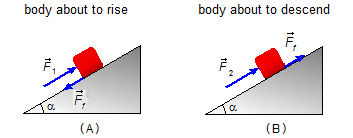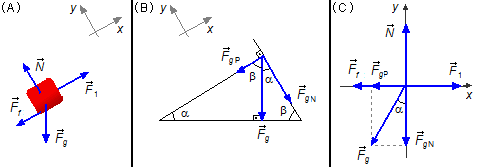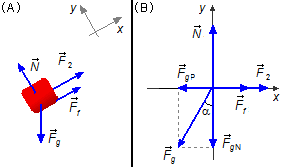Solved Problem on Static Equilibrium
advertisement
A body lies over an inclined plane of an angle α with the horizontal. To move upward it is required a force parallel to the inclined plane whose minimum magnitude is F1 To prevent the body from sliding down is required a force whose minimum magnitude is F2, also parallel to the slope. If F1 = 2F2, calculate the coefficient of friction between the body and the plane.
Problem data:
- Angle of inclination: α;
- Force to make the body rise: F1;
- Force to prevent the body from descending: F2.
We consider that the body is still not moving, in the first case, when the force F1 is applied, the body is about to rise. Due to the applied force, the body acts in the plane, the plane reacts with the friction force of magnitude Ff, as the body is about to climb, the friction force is in the opposite direction of the motion, in a downward direction (Figure 1-A ).

In the second case, when the force F2 is applied, the body is about to descend. Due to the applied force, the body acts in the plane, the plane reacts with the friction force of magnitude Fat, as the body is about to descend the friction force is in the opposite direction of the motion, in an upward direction (Figure 1-B).
Solution
Drawing a free-body diagram, we have the forces that act on it.
We chose a reference frame with the x-axis parallel to the plane in the upward direction and the y-axis perpendicular to the plane.
Body about to rise (Figure 2-A)
- \( {\vec F}_{1} \): force applied to the body;
- \( {\vec F}_{f} \): force of friction between the body and the plane;
- \( {\vec F}_{g} \): gravitational force;
- \( \vec{N} \): normal reaction force of the plane on the body.
\[
\begin{gather}
\alpha +\beta +90°=180°\Rightarrow \alpha=180°-90°-\alpha \Rightarrow \alpha=90°-\alpha
\end{gather}
\]
In the triangle to the right, the normal component makes with the inclined plane a 90° angle, then the angle
between the gravitational force and the normal component measure α, is a complementary angle.

Drawing the forces in a coordinate system xy, we can apply the equilibrium condition
\[
\begin{gather}
\bbox[#99CCFF,10px]
{\sum F=0} \tag{I}
\end{gather}
\]
Direction x:
\[
\begin{gather}
F_{1}-F_{gP}-F_{f}=0 \tag{II}
\end{gather}
\]
the parallel component of gravitational force and friction force are given by
\[
\begin{gather}
F_{gP}=F_{g}\sin \alpha \tag{III}
\end{gather}
\]
\[
\begin{gather}
F_{f}=\mu N \tag{IV}
\end{gather}
\]
where μ is the coefficient of friction between the block and the plane, substituting these expressions
into expression (II)
\[
\begin{gather}
F_{1}-F_{g}\sin \alpha -\mu N=0 \tag{V}
\end{gather}
\]
Direction y:
\[
\begin{gather}
N-F_{gN}=0 \tag{VI}
\end{gather}
\]
the normal component of gravitational force given by
\[
\begin{gather}
F_{gN}=F_{g}\cos \alpha \tag{VII}
\end{gather}
\]
substituting this expression into expression (VI)
\[
\begin{gather}
N-F_{g}\cos \alpha =0\\[5pt]
N=F_{f}\cos \alpha\tag{VIII}
\end{gather}
\]
substituting the expression (VII) into expression (V)
\[
\begin{gather}
F_{1}-F_{g}\sin \alpha -\mu F_{g}\cos \alpha=0\\[5pt]
F_{1}=F_{g}\sin \alpha +\mu F_{g}\cos \alpha\\[5pt]
F_{1}=F_{g}(\sin \alpha +\mu \cos \alpha ) \tag{IX}
\end{gather}
\]
Body about to descend (Figure 3-A)
- \( {\vec F}_{2} \): force applied to the body;
- \( {\vec F}_{f} \): force of friction between the body and the plane;
- \( {\vec F}_{g} \): gravitational force;
- \( \vec{N} \): normal reaction force of the plane on the body.
Drawing the forces in a coordinate system xy, we can apply the equilibrium condition (I)

Direction x:
\[
\begin{gather}
F_{2}+F_{f}-F_{gP}=0 \tag{X}
\end{gather}
\]
substituting expressions (III) and (IV) into expression (X)
\[
\begin{gather}
F_{2}+\mu N-F_{g}\sin \alpha =0 \tag{XI}
\end{gather}
\]
Direction y:
\[
\begin{gather}
N-F_{gN}=0 \tag{XII}
\end{gather}
\]
the normal component of gravitational force is given by
\[
\begin{gather}
F_{gN}=F_{g}\cos \alpha
\end{gather}
\]
substituting this expression into expression (XII)
\[
\begin{gather}
N-F_{g}\cos \alpha =0\\[5pt]
N=F_{g}\cos \alpha \tag{XIII}
\end{gather}
\]
substituting the expression (XIII) into expression (XI)
\[
\begin{gather}
F_{2}+\mu F_{g}\cos \alpha -F_{g}\sin \alpha=0\\[5pt]
F_{2}=F_{g}\sin \alpha -\mu F_{g}\cos \alpha\\[5pt]
F_{2}=F_{g}(\sin \alpha -\mu \cos \alpha) \tag{XIV}
\end{gather}
\]
Using the condition given in the problem
\( F_{1}=2F_{2} \),
we substitute the expressions (IX) and (XIV)
\[
\begin{gather}
\cancel{F_{g}}(\sin \alpha +\mu \cos \alpha)=2\,\cancel{F_{g}}\,(\sin \alpha -\mu \cos \alpha)\\[5pt]
\sin \alpha +\mu \cos \alpha=2\,(\,\sin \alpha -\mu \cos \alpha \,) \\[5pt]
\sin \alpha+\mu \cos \alpha =2\,\sin \alpha -2\,\mu \cos \alpha \\[5pt]
\mu \cos \alpha +2\,\mu \cos \alpha =2\,\sin \alpha -\sin\alpha \\[5pt]
3\,\mu \cos \alpha =\sin \alpha \\[5pt]
\mu=\frac{1}{3}\,\frac{\sin \alpha }{\cos \alpha }
\end{gather}
\]
From the Trigonometry
\( \tan \alpha =\frac{\sin \alpha }{\cos \alpha } \)
\[
\begin{gather}
\bbox[#FFCCCC,10px]
{\mu =\frac{1}{3}\,\tan \alpha}
\end{gather}
\]
advertisement

Fisicaexe - Physics Solved Problems by Elcio Brandani Mondadori is licensed under a Creative Commons Attribution-NonCommercial-ShareAlike 4.0 International License .